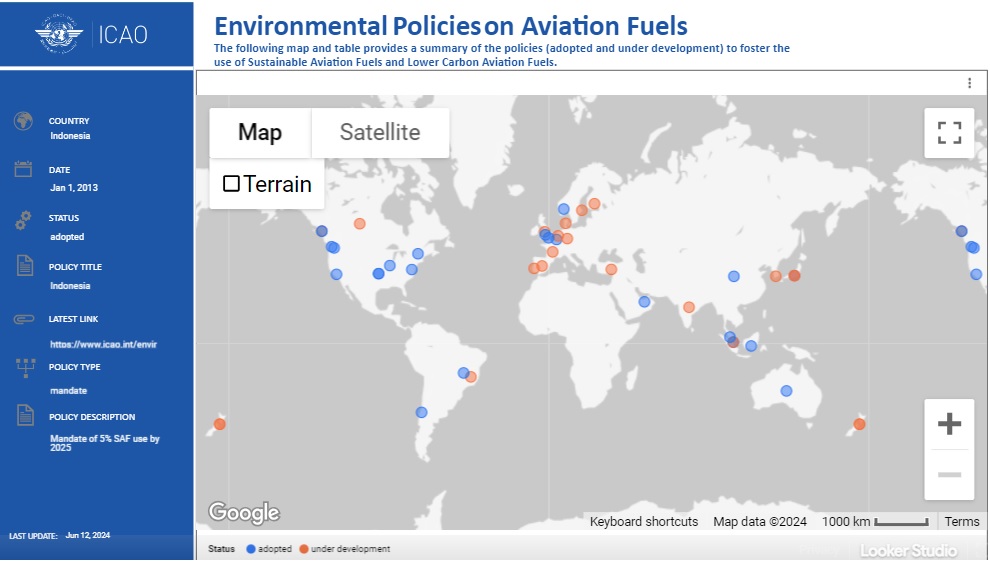ICAO Guidance on Policy Measures for SAF Development and Deployment
|  |
The guidance provides some examples of policy approached implemented by ICAO Member States. Further information on policies being developed or implemented is available on the ICAO Tracker on Environmental Policies for Aviation Fuels, which is updated continuously. |  |
Executive summary
This guidance has been developed by the ICAO Committee on Aviation Environmental based on various studies since 2016. The guidance includes assessments of existing policy instruments, identification of potential policies and general recommendations to facilitate their implementation, and techno-economic analysis of policy options to foster the deployment of SAF. The guidance summarizes a subset of potential policies and coordinated approaches for the deployment of SAF. It complements the ICAO SAF Rules of Thumb, which can be used to make order-of-magnitude estimations related to SAF costs, investment needs, and production potential.
In Section 3, the report provides a comprehensive assessment of what defines an effective SAF policy. The deployment of SAF faces challenges such as high cost of production, limited availability of cost-effective and sustainable feedstock, limited investment, and competition for resources and incentives with other sectors. To overcome these challenges, effective SAF-enabling policies are needed. These should be stable, predictable and consistent, and link incentives to performance, among other characteristics. This section highlights three key themes that influence policy effectiveness: feasibility, effectiveness, and practicality. Effective policies should also be customized to the unique resources, economic and social factors, political barriers, and existing regulatory structure of a particular State or region.
In Section 4, the report describes a set of qualitative metrics used by experts to assess the effectiveness of policies. These metrics can be used as a checklist to evaluate potential or existing policies. There are eight identified metrics, which include flexibility, certainty, financial costs and benefits, price sensitivity to externalities, ease of implementation, contribution to sustainable aviation fuel deployment and GHG reduction, unintended consequences, and robustness of policy. Each metric is described in detail in this section, outlining the characteristics and considerations for policies that would perform well in that metric. These qualitative metrics can be used to rank policies based on their effectiveness by assigning a low, medium, or high score.
In Section 5, the report discusses policy options and examples for creating a sustained market for SAF. It is divided into three main categories of policies: (1) stimulating growth of the SAF supply, (2) creating SAF demand, and (3) enabling the SAF marketplace.
Section 5.1 describes policy types that stimulate SAF supply, increase SAF feedstock and fuel production capacity and supply through research and development (R&D), investment, production incentives, and tax treatment. Such policies can include government funding for SAF RDD&D (research, development, demonstration, and deployment), targeted incentives and tax relief to expand SAF supply infrastructure or SAF facility operation, and recognition and valorization of SAF environmental benefits.
Section 5.2 describes policy types targeted at increasing SAF demand. These include the creation of SAF mandates, which can take various forms depending on the design of the mandate, be it expressed in energy volume or reduction of fuel carbon intensity. Other options include adapting pre-existing policies to include SAF as qualified fuels or incorporating SAF into sub-national, regional, or local policies. Finally, the third category of policies is government leadership, which involves creating demand signals by requiring national, State, and local governments to commit to SAF procurement.
Section 5.3 describes three options to enable SAF markets to function optimally, which include adopting clear and recognized sustainability standards and life cycle GHG emissions methods for certification of feedstock supply and fuel production, supporting the development/recognition of systems for environmental attribute ownership and transfer, and supporting SAF stakeholder initiatives.
In Section 6, the report provides information on two tools developed by CAEP:
"Rules of Thumb" for SAF that could be used to make order of magnitude estimations related to SAF costs, investment needs and production potential with the aim to inform policymakers and project developers; and
A discussion of the concept of SAF cost assessment on the basis of marginal abatement cost of CO2 which allows a policy maker to assess the effectiveness of a specific intervention relative to other alternatives.
In Section 7, the report discusses the impact of policies on the profitability of SAF projects, using examples to illustrate how policies can affect a project's financial viability. The examples demonstrate the sensitivity of a hypothetical project to small changes in input assumptions, highlighting how policy decisions could influence a project's economic merit.
In Section 8, the report provide five examples to demonstrate how policies can impact the profitability and minimum selling price (MSP) of SAF projects. It also explores how stacking multiple policy mechanisms can move MSP toward price parity with conventional kerosene.
Appendix A contains a table summarizing all policy options described in Section 5.
Appendices B, C, and D provide policy approach examples, respectively from the European Union, the United Kingdom, and the United States.